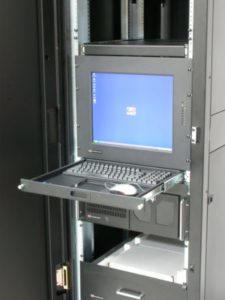Before the 1980’s most of computing happened in centralized mainframe or mid-sized computers. Users accessed shared computing resources thorough “dumb terminals” (those green-screen terminals displaying text-based interfaces we used to see in commercial applications). Those terminals often connected using serial (RS-232 interfaces) directly to the main computer.
Not so Dumb After All
 As computers got connected to a network and there were enough dumb terminals that were not network-enabled, there was a need for an appliance that converted RS-232 connections to network connections so that users at dumb terminals could continue to access the main computers. That appliance was a called a terminal server, and some of the early devices were manufactured by Digital Equipment Corporation (DEC).
As computers got connected to a network and there were enough dumb terminals that were not network-enabled, there was a need for an appliance that converted RS-232 connections to network connections so that users at dumb terminals could continue to access the main computers. That appliance was a called a terminal server, and some of the early devices were manufactured by Digital Equipment Corporation (DEC).
In the 1990’s most business applications started moving to PC computers, but serial terminals could still be seen in gas stations, retail stores and other places using legacy commercial applications. By then, several companies were selling Terminal Server appliances.
When the commercial Internet arrived in the mid 90’s, some of those Terminal Server vendors saw an unexpected high demand for their previously declining products. Internet pioneers like Yahoo! were building the first Internet data centers and found that Terminal Servers could be used “upside-down” to allow for management of a large number of Internet servers. Rather than connecting the terminal from the RS-232 ports to the network, this use case allowed users coming from the network to gain remote access to the RS-232 ports, which were in turn connected to the management (console) ports of servers and network equipment.
Terminal Server on Steroids
Some terminal server vendors, noticing the new trend, developed software features targeted at making the old appliances more effective as a tool to manage servers in a data center and remote sites. Those features included increased security and facilities to make it easier for the user to select ports without having to type in specific addresses or port numbers.
To differentiate the new products from old terminal servers and also to more accurately describe the new use case, those vendors started referring to the new products as “Console Access Server” or “Console Server”. A new product category was created and the “Out-of-Band Management” became the standard term to describe the new market space.
Not everyone adopted the new terminology, so we still see Console Servers being called the name used to designate the old appliance that connected terminals to a central computer. We can even find old terminal servers designed more than 20 years ago being used to manage console ports.
The current generation of console servers now support high-density applications (up to 96 ports in a single unit), enable zero touch provisioning, and often feature embedded cellular modules to allow access even when the primary network is down. With all of these new features, it seems as shame to still dismiss them as “terminal”!


